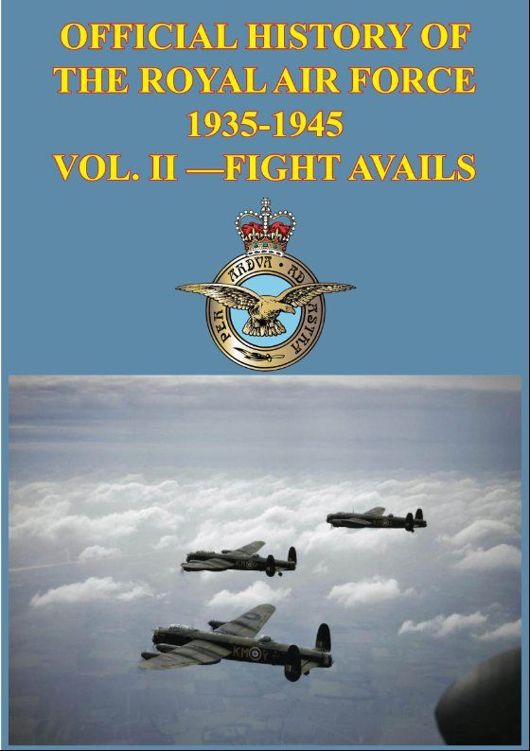PREFACE
The purpose and scope of this history were described by the late Hilary Saunders and myself in our general preface, printed in the first volume. Here it is perhaps sufficient if I recall that the story is, for reasons of space, confined largely to operations and the policy governing them: that it is not part of the full-length Official History of the War, and is intended for a somewhat wider audience: that it was, nevertheless, officially commissioned, and is based throughout on official documents, to which the fullest access was given: and that the authors, while gratefully acknowledging official help and advice, are alone responsible for the statements made and the views expressed.
For help with this volume, as with the others, our debt was particularly great to the Air Ministry Historical Branch, under Mr. J. C. Nerney. Indeed, without the assistance of that admirable organization, always fully and freely at our service we could hardly have begun our task, let alone finished it.
The text of this volume, like that of volumes one and three, was substantially completed during 1950. The first four and the last four chapters were written by Hilary Saunders, the middle eight by myself. My friend and collaboratore, however, did not leave to read the printer's profs. Throughout the whole period of his work on this history he was in fact struggling against ill health. His premature death was assuredly a direct result of immense labours, from 1940 onwards, to bring home to his fellow-countrymen the full measure of the achievement of those whose battlefield was 'the blue dome of air'.
D.R.
November 1953
CHAPTER I Japan Strikes
On a bright morning in the early summer of 1925 three men, each of them at the head of his branch of the profession of arms, were sitting in conference in Whitehall Gardens. The subject of their discussion was the defence of an island, about the size of the Isle of Wight, situated more than eight thousand miles from the United Kingdom near the eastern entrance of the Strait of Malacca. Upon its southern shore lay a large, humid, opulent city, upon its northern the beginning of a naval base which in course of years was to be variously described as 'the Gibraltar of the Far East', 'the Greatest Arsenal of Democracy in South Eastern Asia', and 'an impregnable fortress'. When completed at a cost of 60,000,000 it was stocked with naval equipment of every kind from a cap-band to a 15-inch shell and off it granite and concrete quays floated a dry-dock, 1,000 feet long and 132 feet wide, able to hold the largest battleship. In February, 1942, the base, the city and the island endured a siege of fifteen days. At the end of it, 70,000 exhausted defenders surrendered to 100,000 Japanese and passed into a captivity, so rigorous and brutal, as to bring about the death of more than half of them. The fall of Singapore was as great a disaster as British arms had ever sustained.
All this was seventeen years in the future when the three men sat at their deliberations that May morning in London. As they proceeded it became evident that they were not in full agreement. The subject of their discussion was how best to provide for the defence of the slowly growing docks and arsenals of the new base. It had been decided in 1921 to remove the main naval base in the Far East from its remote and exposed position at Hong King, and the Committee of Imperial Defence had had under scrutiny for two years the strategic problem provided by the greatly enlarged and continually expanding navy of Japan. Should Great Britain and that country fall to war, a more central and safer spot for the Far Eastern naval base was essential. The Committee thought that they had found it on the island of Singapore and their choice was confirmed by the Imperial island of Singapore and their choice was confirmed by the Imperial Conference of 1932. Two years passed and still the experts debated the best methods of defending it. The First Sea Lord and the Chief of the Imperial General Staff favoured that form of defence which a heavy fixed armament of 15-inch guns, accompanied by cannon of smaller calibre, could provide. It was well tried. In one form or another it had stood the test of many wars. Sir Hugh Trenchard, Chief of the Air Staff, preferred a more mobile and far-ranging scheme. To the guns, the submarines, the light surface craft, should be added a squadron of fighter aircraft, two of torpedo bombers and a flight of seaplanes. The installation of immovable 15-inch guns in a fortress where they could have no effect beyond their own range and 'where, in many wars, they would exercise no effect whatsoever' was, he maintained, a mistake if they were to be the only, or the principal, form of defence. Why not use the air force to strike at the enemy long before he came within their range? Torpedo bombers could do so far out to sea, 150 to 200 miles from Singapore and the great guns.
Such revolutionary notions provoked much discussion. A compromise was eventually adopted, and it was agreed that the first stage of defence should be represented by three 15-inch guns and a complement of ordnance of smaller calibre, and that the second stage should make provision for torpedo aircraft.
For ten years from 1927, the pendulum swing uneasily between guns and aircraft, economy and lavishness. By 1929 the floating dock was in position, and more guns had been added to the defence, and No. 205 Squadron, equipped with Southampton and later with Singapore flying boats, was stationed at Seletar near the still uncompleted naval base. In 1930, when large economies in expenditure on armaments had become necessary, it was reinforced by No. 36 (Torpedo Bomber) Squadron. The completion of the defence scheme as a whole, however, was postponed for five years. Then in 1931 the outbreak of what amounted to war between China and Japan gave rise to apprehensions which two years later led to the despatch of a second Torpedo Bomber Squadron, No. 100, to Singapore, and the leisurely construction of two airfields. At that time the Air Staff was probably alone in believing that Singapore might be assaulted from some other direction than from the sea. The enemy's fleetand it was obvious to all that the potential enemy was Japanwas expected to attack the base supported by carrier-borne aircraft. To combat this form of assault reconnaissance squadrons were necessary, backed by squadrons capable of a sustained offensive against shipping. They would be provided.












